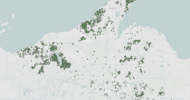Joong Ang Daily | January 29, 2011
Even if the agricultural sector’s effect on prices is contained, there is no guarantee high inflation will be absent.
By Chung Jin-young
Fears over inflation are deepening. Consumer prices rose 3.5 percent in December compared to a year ago, while producer prices increased 5.3 percent and import prices 12.7 percent. Driving up consumer prices were agricultural products, which leaped 26.5 percent on the back of a 33.8 percent surge in fresh produce prices. Among import prices, agricultural, forestry and fisheries product prices soared 30.8 percent.
The backdrop to the price spike is a mosaic of supply-side factors. With rising demand for raw materials by commodity importers like China, demand-supply dynamics are being recalibrated. In addition, the weakening U.S. dollar and expanding global liquidity have prompted speculative demand, putting upward pricing pressure on commodities, including oil.
The price of Dubai crude, which Korea depends on, climbed to $93.20 per barrel as of Jan. 14, far higher than the $80 average estimated for 2011. Net-long positions of noncommercial traders in Dubai crude futures also surged in the fourth quarter of 2010, reflecting the rising oil prices coming from speculative demand.
Meanwhile, the agricultural sector is under mounting stress. Low harvest outlooks due to extreme weather plus rising demand from consumers in emerging economies are fanning concerns over food price inflation, or agflation. According to the United Nations Food Association Organization, the fresh food price index, which has a bearing on Korean domestic prices, rose 32 percent in the second half of 2010. Rising raw material prices have spurred demand for bioenergy, leading to upward price pressure on corn, soybean oil and rapeseed oil, which are needed to produce bioethanol and biodiesel.
Another source of imported inflation is coming from China, Korea’s biggest trade partner. Chinese products, 16.9 percent of Korean imports, are arriving with higher price tags, which are passed on to consumers.
Fortunately, upward price pressure from the demand side has been arrested so far. Considering the stable core inflation rate and a negative GDP gap rate, inflationary pressure coming from demand factors such as easy credit and rising incomes has yet to appear.
Although overall consumer prices are trending upward, the core inflation rate remains stable at 2 percent (in December 2010). The GDP gap rate, which fell to negative 3.2 percent right after the collapse of U.S. investment bank Lehman Brothers in September 2008, has improved, and is likely to post a negative 0.5 percent. This means that actual GDP will remain below potential GDP, or a slight slowdown in 2011. That will constrain demand side pressure on inflation this year.
Since rising prices are coming from the supply side and external factors, short-term plans to tame inflation should be on a micro level. They could include a freeze on public utility charges, stabilizing monthly rental prices and farm product prices and containing education costs. These are all related to stabilizing prices related to low-income households. According to the industry input/output table in 2005, the pace of rise in consumer prices from increasing public utility charges topped the pace of inflation from rising oil prices.
At the same time, measures will be needed to prevent price stabilization steps that raise the tax burden. But the most important effort will be to dispel inflation fears.
Even if prices are stabilized, fears over future inflation would be enough for households to rein in domestic consumption and crimp the economy, which already is expecting a slowdown in all-important exports this year. In this regard, it is crucial for the government to focus policy on fears of inflation through micro measures.
Because food is the most frequent purchase, consumer perception and subsequent expectation about inflation exceed what actual data reveals and suggests. Nevertheless, there is no denying that farm products are the main cause of the recent inflation surge. Thus, fundamental measures should focus on preventing agflation. The uncertainty over domestic grain production should be eased while the distribution of domestic farm, fisheries and forestry products should be effectively managed to stabilize these prices.
In addition, it is crucial to secure overseas agricultural suppliers to cope with speculative demand and global climate change. Building overseas food production bases, developing overseas food resources and vitalizing direct overseas transactions and diversification of import sources are crucial. Introduction of a way to import grains through the grain futures market can help strengthen risk management of import grain prices, while introducing an early warning system for a stronger monitoring of the international grain market.
Even if the agricultural sector’s effect on prices is contained, there is no guarantee high inflation will be absent. If currently stable service prices rise, the government’s price stabilization measures can lose their effect. Service prices account for 60 percent of Korea’s consumer prices, so any fast, appreciable increases would likely stir as much discontent as the current rise in food prices.
*The writer is research fellow at Samsung Economic Research Institute. For more reports, please visit www.seriworld.org.














